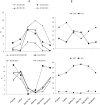Seasonal Dynamics in the Chemistry and Structure of the Fat Bodies of Bumblebee Queens
- PMID: 26559946
- PMCID: PMC4641598
- DOI: 10.1371/journal.pone.0142261
Seasonal Dynamics in the Chemistry and Structure of the Fat Bodies of Bumblebee Queens
Abstract
Insects' fat bodies are responsible for nutrient storage and for a significant part of intermediary metabolism. Thus, it can be expected that the structure and content of the fat body will adaptively change, if an insect is going through different life stages. Bumblebee queens belong to such insects as they dramatically change their physiology several times over their lives in relation to their solitary overwintering, independent colony foundation stage, and during the colony life-cycle ending in the senescent stage. Here, we report on changes in the ultrastructure and lipid composition of the peripheral fat body of Bombus terrestris queens in relation to seasonal changes in the queens' activity. Six life stages are defined and evaluated in particular: pharate, callow, before and after hibernation, egg-laying, and senescence. Transmission electron microscopy revealed that the fat body contained two main cell types-adipocytes and oenocytes. Only adipocytes reveal important changes related to the life phase, and mostly the ration between inclusion and cytoplasm volume varies among particular stages. Both electron microscopy and chemical analyses of lipids highlighted seasonal variability in the quantity of the stored lipids, which peaked prior to hibernation. Triacylglycerols appeared to be the main energy source during hibernation, while the amount of glycogen before and after hibernation remained unchanged. In addition, we observed that the representation of some fatty acids within the triacylglycerols change during the queen's life. Last but not least, we show that fat body cell membranes do not undergo substantial changes concerning phospholipid composition in relation to overwintering. This finding supports the hypothesis that the cold-adaptation strategy of bumblebee queens is more likely to be based on polyol accumulation than on the restructuring of lipid membranes.
Conflict of interest statement
Figures




Similar articles
-
Untargeted Lipidomics Analysis Unravels the Different Metabolites in the Fat Body of Mated Bumblebee (Bombus terrestris) Queens.Int J Mol Sci. 2023 Oct 21;24(20):15408. doi: 10.3390/ijms242015408. Int J Mol Sci. 2023. PMID: 37895088 Free PMC article.
-
Harmonic radar tracking reveals random dispersal pattern of bumblebee (Bombus terrestris) queens after hibernation.Sci Rep. 2019 Mar 20;9(1):4651. doi: 10.1038/s41598-019-40355-6. Sci Rep. 2019. PMID: 30894590 Free PMC article.
-
Size-dependent responses of colony-founding bumblebee (Bombus impatiens) queens to exposure to pesticide residues in soil during hibernation.Sci Total Environ. 2024 Oct 20;948:174852. doi: 10.1016/j.scitotenv.2024.174852. Epub 2024 Jul 18. Sci Total Environ. 2024. PMID: 39029756
-
Annual lipid cycles in hibernators: integration of physiology and behavior.Annu Rev Nutr. 2005;25:469-97. doi: 10.1146/annurev.nutr.25.050304.092514. Annu Rev Nutr. 2005. PMID: 16011475 Review.
-
The fat body of termites: functions and stored materials.J Insect Physiol. 2013 Jun;59(6):577-87. doi: 10.1016/j.jinsphys.2013.03.009. Epub 2013 Apr 3. J Insect Physiol. 2013. PMID: 23562782 Review.
Cited by
-
Flexibility in the Critical Period of Nutrient Sequestration in Bumble Bee Queens.Integr Org Biol. 2021 Apr 19;3(1):obab009. doi: 10.1093/iob/obab009. eCollection 2021. Integr Org Biol. 2021. PMID: 34104874 Free PMC article.
-
Diet and nutritional status during early adult life have immediate and persistent effects on queen bumble bees.Conserv Physiol. 2019 Aug 15;7(1):coz048. doi: 10.1093/conphys/coz048. eCollection 2019. Conserv Physiol. 2019. PMID: 32802333 Free PMC article.
-
Dynamic Changes of Gut Microbial Communities of Bumble Bee Queens through Important Life Stages.mSystems. 2019 Dec 10;4(6):e00631-19. doi: 10.1128/mSystems.00631-19. mSystems. 2019. PMID: 31822600 Free PMC article.
-
The effect of intrinsic physiological traits on diapause survival and their underlying mechanisms in an annual bee species Bombus impatiens.Conserv Physiol. 2020 Dec 4;8(1):coaa103. doi: 10.1093/conphys/coaa103. eCollection 2020. Conserv Physiol. 2020. PMID: 33304588 Free PMC article.
-
Characterization and Developmental Expression Patterns of Four Hexamerin Genes in the Bumble Bee, Bombus terrestris (Hymenoptera: Apidae).J Insect Sci. 2021 Sep 1;21(5):13. doi: 10.1093/jisesa/ieab078. J Insect Sci. 2021. PMID: 34636890 Free PMC article.
References
-
- Buchmann SL, Hurley JP. A biophysical model for buzz pollination in angiosperms. J Theor Biol. 1978; 72:639–657. - PubMed
-
- Banda HJ, Paxon RJ. Pollination of greenhouse tomatoes by bees. Acta Hortic 1991; 288:194–198.
-
- Sladen FWL. The bumblebee. London: Mac Millan; 1912.
-
- Schmid-Hempel R, Schmid-Hempel P. Female mating frequency in Bombus ssp from Central Europe. Insectes Soc. 2000; 47:36–41.
-
- Šobotník J, Kalinová B, Cahlíková L, Weyda F, Ptáček V, Valterová I. Age-dependent changes in structure and function of the male labial gland in Bombus terrestris . J Insect Physiol. 2008; 54:204–214. - PubMed
Publication types
MeSH terms
Substances
LinkOut - more resources
Full Text Sources
Other Literature Sources

